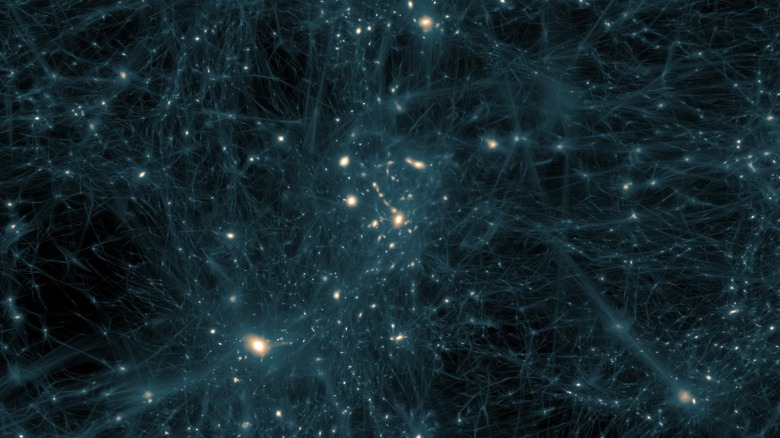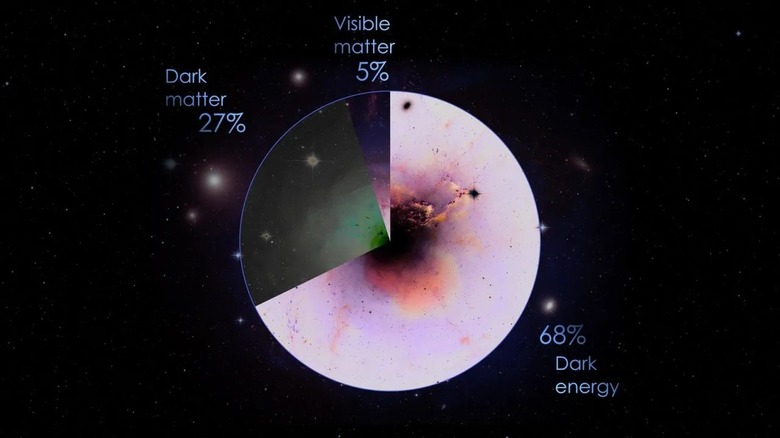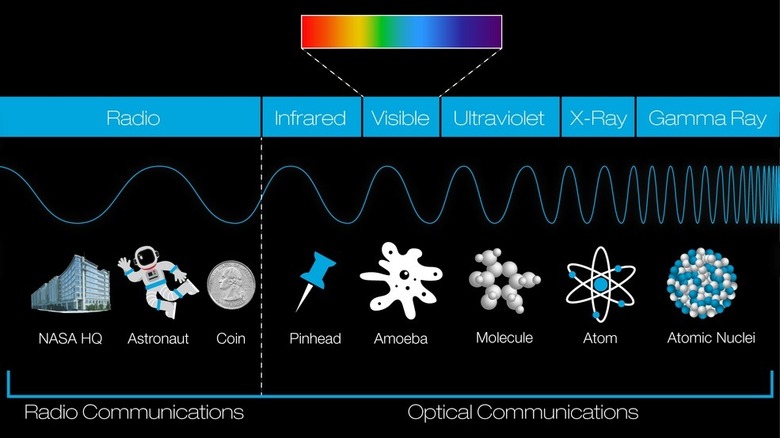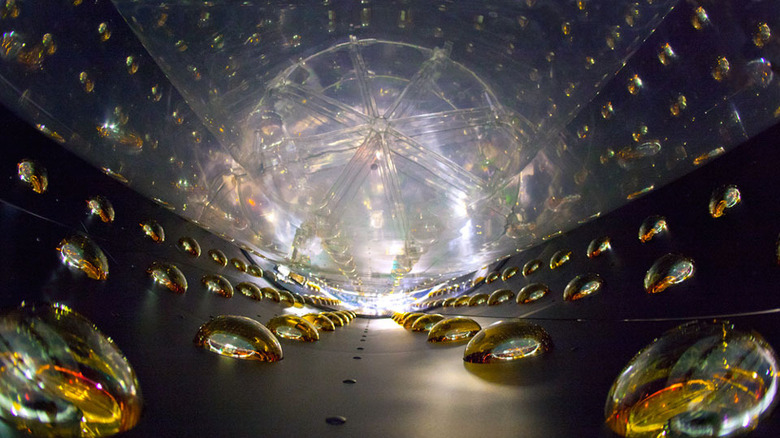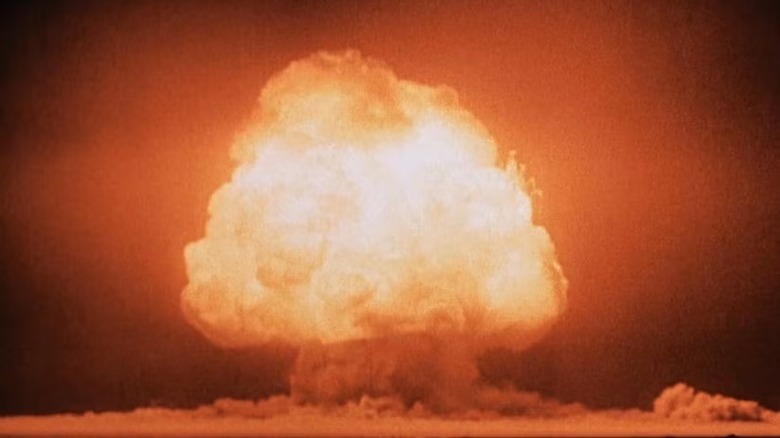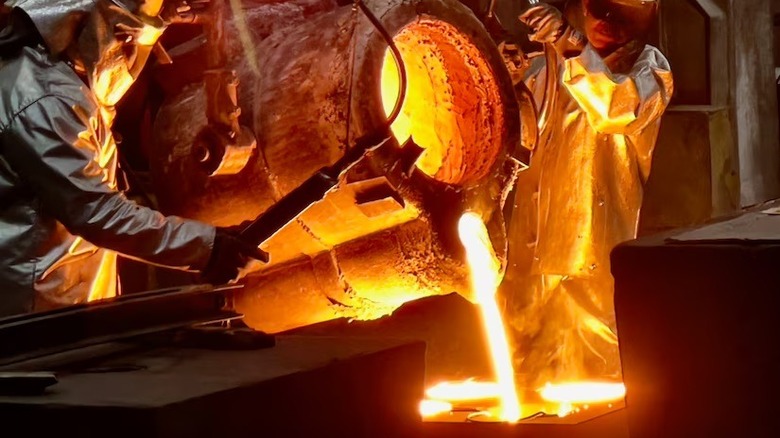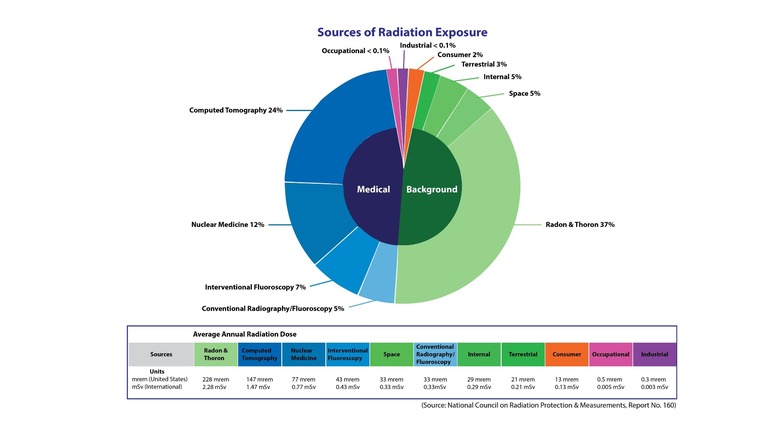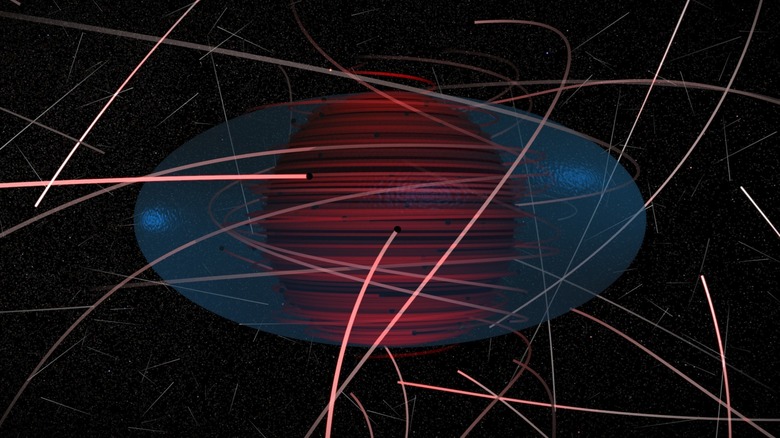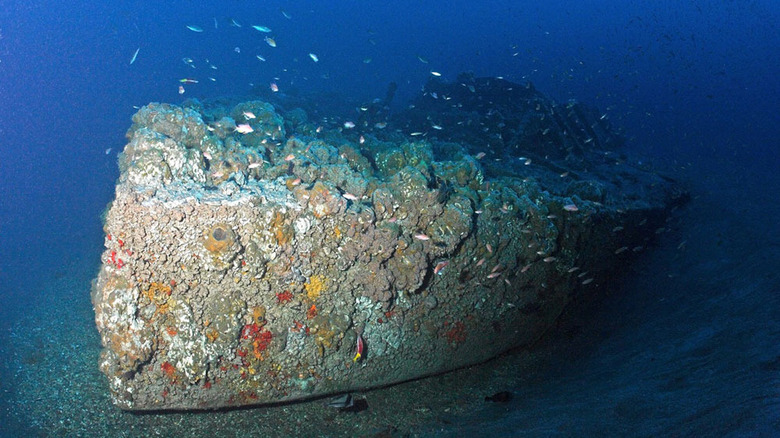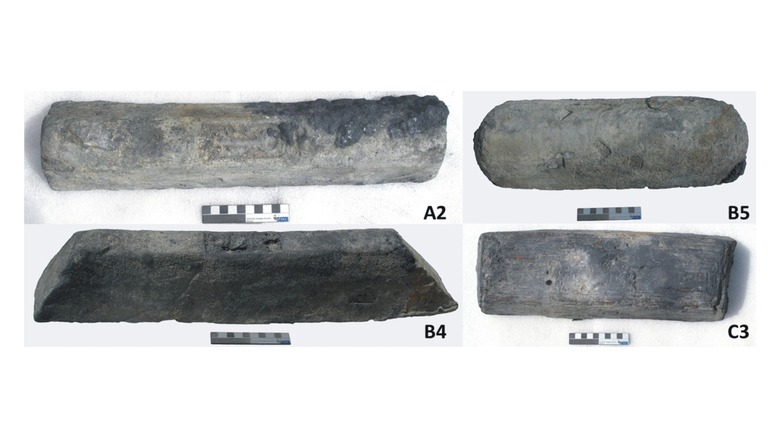Why Scientists Are Mining Historical Shipwrecks For Dark Matter Experiments
The nature of dark matter is one of the leading mysteries in modern astronomy. In fact, the name "dark matter" is essentially a placeholder for something astronomers know is there but can't yet thoroughly investigate. Dark matter doesn't interact electromagnetically, so it doesn't absorb or give off light. It doesn't seem to interact with ordinary matter or radiation at all, except through its gravitational influence. That's how astronomers know it's there, by the way ordinary matter moves around it.
Today, astronomers and physicists use increasingly complex space-based telescopes like Hubble and JWST to probe the distant reaches of the observable universe by detecting visible and invisible light. They use supercolliders to crash tiny particles into one another at nearly the speed of light, to recreate the conditions of the Big Bang, and they construct highly sensitive laser-based instruments for detecting gravitational waves created during the distant mergers of massive black holes. Astronomical history is checkered with seemingly impossible problems followed by cleverly designed experimental solutions.
Right now, scientists are busily designing and constructing similarly complicated experiments, for detecting dark matter right here on Earth. Surprisingly, some of the most advanced astronomical experiments in human history depend on salvaging metal (legally and illegally) from historical shipwrecks on the seafloor.
What is dark matter? (What we know so far)
The origin of dark matter as a field of astronomical study is somewhat murky, but Fritz Zwicky is generally credited with coining the term in 1933, while Vera Rubin is credited with presenting compelling evidence of dark matter, demonstrated through the rotation and structure of galaxies, in the '70s.
You probably remember learning in grade school that everything from the most massive galaxy to the tiniest atom is made of ordinary matter, but that's only a small part of the cosmic story. Of the total mass-energy mix of the universe, about 68% is dark energy, 27% is dark matter, and only 5% is ordinary matter. Dark energy is a whole other story, involving the expansion rate of the universe, and we won't get into it here. If we take dark energy out of the mix, then ordinary matter makes up only 15% of the stuff in the universe, and the rest is dark matter.
Not only can astronomers see the influence of dark matter in the movements of galaxies, but our current cosmological models insist on the presence of dark matter, or else they don't work. Without the gravitational influence of dark matter, the structure and motion of galaxies wouldn't be possible. We know that for every particle of ordinary matter in the universe, there are approximately 6 dark matter particles, gravitationally warping spacetime. Yet, for now, they remain outside of our grasp.
Why is dark matter so hard to detect?
Ordinary matter, from the smallest quark to the most massive star interacts electromagnetically. One of the consequences of that interaction is that we can see it. When you point a telescope at ordinary matter, you can catch the light coming off it and learn something about it.
Light comes in many different forms, with a variety of frequencies and wavelengths. Our eyes are only capable of seeing a small section of that spectrum, what we call visible light. Our eyes collect that light and our brains interpret differences in wavelength as a difference in color, ranging from red to violet. Our eyes can't perceive light with shorter wavelengths (UV, X-ray, and gamma rays) or longer wavelengths (infrared, microwave, and radio), but our telescopes and other instruments can. Almost everything we know about the universe, we know from looking at its light, but dark matter doesn't follow the same rules.
As far as we can tell, dark matter is almost totally non-interactive, which makes it incredibly difficult to detect. It's so non-interactive that scientists estimate you could fire a dark matter particle through 10 million light-years of lead and only have a single nuclear interaction along the way. Designing a detector capable of picking up on those exceedingly rare interactions is a challenge.
Underground neutrino detectors
Neutrinos aren't dark matter — they move too fast to clump together in the right ways, for one thing — but they share some characteristics with dark matter that make them a good jumping off point. Neutrinos are small fundamental particles with a neutral charge (hence the name).
They are the most abundant particles with mass in the universe, created mostly in the hearts of stars. Deep in the middle of a star, the pressure is so intense that individual hydrogen atoms fuse together, creating helium and releasing energy. As the two atoms become one, they create offspring in the form of neutrinos which fly through the hot plasma of the sun and emerge from the surface. Moving at nearly the speed of light, they get to the orbit of Earth in a little over eight minutes. Billions of them pass through your body, through the entire planet, and fly out the other side every second of every day. Even at night, neutrinos are striking the day side of the planet, going through it and you, into deep space.
To detect them, scientists place detectors approximately a mile underground. That way, any other radiating particles get absorbed by the planet before they get to the detector. Only the rarely interacting neutrinos get through. Then they wait for the incredibly small percentage of those neutrinos to interact with an atom in the detector. Scientists are using similar instruments and methods as a starting point for dark matter detectors.
The atomic age
On July 16, 1945, just 12 years after Fritz Zwicky proposed dark matter in 1933, another physicist, J. Robert Oppenheimer, succeeded along with the rest of the scientists at Los Alamos in unleashing the destructive power of the atom.
Over the next few decades, several nations around the world developed and tested nuclear weapons. In addition to the two bombs dropped on Hiroshima and Nagasaki, those nuclear weapons tests introduced radioactive fallout that spread around the world. Background radiation rates on Earth remain low enough that most of us don't have to worry about walking around town, but building sensitive instruments has become more difficult because modern metals are contaminated with nuclear fallout.
Humanity's atomic adolescence left a radioactive bruise on the planet that lingers to this day. The amount of background radiation has declined since the mid-20th Century but it's still higher than it was before we built those first bombs. Radiation levels peaked at 0.11 millisieverts (mSv) in 1963 and have since dropped to just 0.005 mSv. Experts note that, while the radiation rate has declined, the remainder is largely the result of carbon-14, which is long-lived and will subside slowly. That presents a problem for scientists hoping to detect dark matter today.
Making Steel in the atomic age
Steel manufacturing strategies have evolved over the decades but every metal-making method introduces some level of environmental contamination. Conventional steel-making processes use atmospheric gasses (either whole air or pure oxygen) at various points, which introduces atmospheric radiation into the end product.
Generally speaking, steel is made in one of two ways. First, pig iron (crude iron) is mixed with oxygen to lower its carbon content and transform it into low-carbon steel. The process is called basic oxygen steelmaking, not because the process is simple, but because it introduces calcium oxide and other chemical bases into the metal mix. Alternatively, electric arc furnaces take scrap metal and apply an electrical current to melt it down, using oxygen injectors to help control the temperature. No matter the method, contaminants from the air make their way into the steel.
For most everyday uses, the background radiation rate of modern steel is low enough to get by, but the sensitive instruments needed for the detection of dark matter need to be cleaner than modern steel allows.
Avoiding background radiation
Ambient background radiation presents a particular challenge for dark matter science, because the hypothetical dark matter interactions are expected to be very low energy. Trying to detect them in an ordinary lab with ordinary materials would be like trying to hear a whisper in another room while playing the drums.
The word "radiation" conjures images of nuclear disasters and comic book superheroes, but we're surrounded by low-level radiation all the time. Ambient radiation comes from cosmic particles, from the planet itself, from bananas, and people, and all sorts of other things. Much like heat, the real question isn't whether or not radiation is there, but to what degree.
While the amount of day-to-day radiation is low enough to live in, it's loud enough to drown out the sensitive experiments. A successful dark matter detector must be able to differentiate rare and subtle dark matter data from background noise.
Designing a dark matter detector
Various experiments are being designed and deployed at sites around the world, and most of them are built on similar principles. You start with a tank of some pure material like liquid xenon and you stick it a mile underground. Getting your chemical filler as pure as possible is critical for detecting subtle nuclear reactions from things like neutrinos and, hopefully, dark matter. Next, you surround your tank of xenon with photomultiplier tubes (PMTs) capable of detecting incredible subtle light signatures, even down to a single photon.
The idea is that a dark matter particle will on occasion strike a xenon atom inside the core of the detector. If that happens, it should cause a nuclear recoil and knock an electron loose. The recoil will accelerate the xenon atom, producing a burst of light detected by the PMTs. Then the free electron will float up through the xenon, following the path of an electric field, and be detected at the top. Those two bits of information from the same tiny event should reveal information about the dark matter particle that caused it.
Every element of a dark matter detector, from the xenon in the center to the housing, cabling, and electronics have to be as free from radiation, dust, and other contaminants as possible.
Searching the stars with salvaged shipwrecks
Whether the scientists at Los Alamos knew it or not, humanity accidentally set a nuclear booby trap for itself during the second World War. As a result of widespread, low-level nuclear fallout, all of the readily available modern steel is too tainted to detect dark matter.
Everything about a dark matter detector is designed to eliminate noise in the data. They even nest multiple detectors on top of one another to veto any non-dark matter particles that slip through. These instruments are laboriously designed to be as sensitive and accurate as possible, but all of it is for nothing if the detector itself is too radioactive. The solution is to find metal manufactured decades or centuries ago, before the invention of nuclear weapons.
In some scientific circles, what's become known as "low-background steel" has become something of a commodity because of its usefulness and its limited nature. Low-background steel is commonly recovered from shipwrecks at the bottom of the oceans. They were made before atomic weapons and they've had time for some of their inherent radiation to bleed off. If you want metal that's as radioactively quiet as possible, you can't do much better than a shipwreck and that's resulted in more than a little bit of controversy.
The controversial cost of cosmological progress
In some cases, low-background steel is so valuable that people have illegally plundered shipwrecks in order to sell them for parts to any scientists willing to pony up the dough. In addition to the legally nebulous origins of some low-background steel, even some of the materials obtained legally have come with a controversial cultural cost.
A couple of scientific instruments, one in the United States and one in Europe are constructed in part from metal ingots recovered from shipwrecks. The Cryogenic Dark Matter Search (CDMS) in Minnesota is constructed from lead ingots retrieved from an 18th Century wreck found off the coast of France. The Cryogenic Underground Observatory for Rare Events (CUORE) in Italy is made from 2,000-year-old ingots recovered from a Roman ship that sank off the coast of Sardinia. Those ingots are especially useful because lead becomes even less radioactive over time.
Before the metal is repurposed, any historical inscriptions are removed and preserved, but there is something uncomfortable about destroying historical relics to build modern machines. Consequently, there is ongoing conversation between archaeologists and physicists about how best to balance the future progress of particle physics with the preservation of our terrestrial past.
